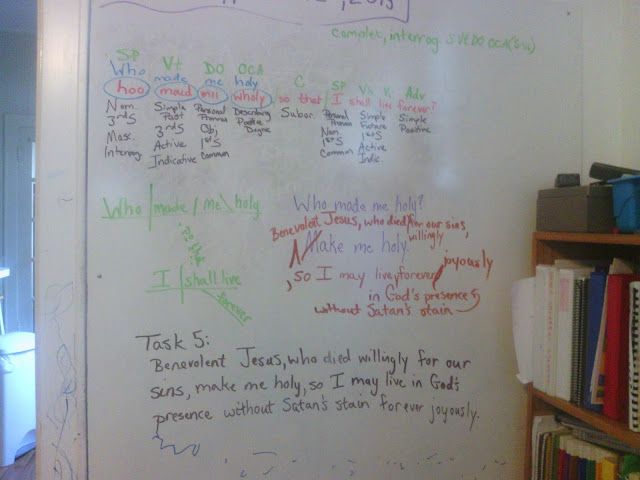DISCLAIMER: Please preview all resources before showing them to your children. What I consider acceptable for my young men may not pass your inspection.
Foundations Week 20 of
Classical Conversations finds us soaring through the layers of the atmosphere, learning about our neighbor to the south, and gettin' jiggy with one of my favorite mathematical constants, pi. We have tons of opportunity to know God and make Him known through our new grammar this week!
Orchestra:
As we ease into learning about the orchestra, it's advisable to introduce our dear cherubs to the instrument families through pieces of music that feature them. My favorite go-to pieces for this task are to introduce the brass and percussion with Also Sprach Zarathustra by Strauss, well known to geekdom as the theme to
2001: A Space Odessey, and to introduce strings through
Pachebel Canon in D. Other families can be mentioned in passing as they are not important and quite annoying. Yes, woodwinds. I'm talking to you. Brass is in the house, booooy.
Anywho...
It's also a great time to talk briefly about the timeline of instrument development through the boom of organized military during the age of monarchs which led to the development of bigger [and thus louder] artillery. This meant that to communicate on the battlefield, the noble brass and percussion were no longer loud enough. Thank you, war, for cursing us with the migraine-inducing piccolo. Thank you. It's the gift that keeps on piercing.
As instruments were developed, the aristocracy surrounding rising monarchies needed entertaining...after all, we are endowed by our Creator with a need for the arts of other human beings. The intense need for the arts, however, often does not rear its powdered and well-coiffed head until we have the leisure time to enjoy it.
Consider the rise of the noble classes, and eventually the middle class, that led to the revival of theaters and permanent stages. Entertainers were no longer
all forced to live the troubadour lifestyle of the Middle Ages and the Renaissance. The best ones could stay in one place and have people flock to see them. Larger venues meant larger stages that could hold more and more musicians. We see a huge jump in the size of the orchestra from the Baroque to the Classical Period. Check out the fantastic
Dallas Symphony Orchestra's educational website for games, composer biographies, timelines, and more.
My kids also greatly enjoy
Classical Kids CD's [check you library for them or talk your dear librarian into investing in them...let me know if you have trouble. I am totally fluent librarianese] and the
Kids Classical Hour.
Dealing specifically with this week's piece, this short program from
Ted and Fred of NPR shares information about Handel and his Water Music.
New Grammar:
The history of Mexico
is so fraught with danger, excitement, and imperialism!
The CrashCourse channel on YouTube has several episodes on Imperialism, Colonialism, and South America. Lake
Texcoco is important because the
Aztecs built their city of Tenochtitlan
on an island in the lake, then the Spaniards built Mexico
City on top of the conquered city.
Scholars have used information gleaned from
the archaeological sites at Mayapan to learn much of Pre-Columbian Maya
culture:
http://www.albany.edu/mayapan/
And Oaxaca is
fun to say.
The wikipedia article has some beautiful pictures of the
many cathedrals and churches in Oaxaca. The city has some beautiful colonial
architecture. [Also, there are A LOT of
restaurants in the world called Monte Alban. Just try to google some archaeological
information about it! All I turned up
were fine dining establishments.].
Chichen Itza is
another big Mayan city.
The largest
temple in it, known as
El Castillo [“the castle”], is a famous landmark to show
your kiddos.
Now for something completely different. I love pi. And pie. I always enjoy applying a little pi with my children. My favorite way to see pi in action involves something round and a non-stretchy string. I find the circumference of the round object with the
string, then show the children that the diameter of the round thing can be used to measure the
circumference’s length. It fits three
times, with a tiny bit left over. Does
that ring a bell? Three with a little bit left over? 3.14!
Rad.
Do it. Your mind will be blown.
I'll wait.
Now, let's experience the layers of the atmosphere with a guy named Felix, shall we? The atmosphere - not just an ocean of gases surrounding our lush, verdant world. It is also a place where boys think up bigger and badder stunts to scare their poor mothers. My kids have also been interested to learn about the aurora that occur in the thermosphere.
Enjoy your children every minute you can! Delight with them in the gift of learning!
Open the pod bay doors, Hal.
I'm afraid I can't do that, Dave.












